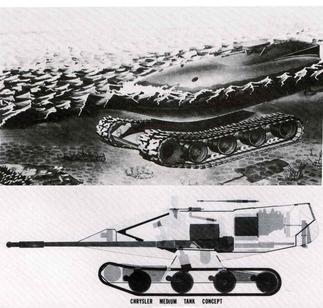Chrysler_TV-8.jpg

Recently, I posted a series of articles on ideas for nuclear weapons and delivery platforms that proved too expensive, dangerous or ineffective to actually construct and deploy. Today I am going to blog about proposals for a nuclear-powered tank.
In the 1950s, Chrysler developed a design for a nuclear-powered tank and built a prototype with a gasoline engine. The big argument in favor of using a nuclear engine on a tank is the fact that it would give the tank a virtually unlimited range. Such a tank, had it been built, would probably have had something like a four-thousand-mile range. Not needing a conventional fuel such as gasoline or diesel would have reduced the logistical overhead for the tank. A nuclear fission-powered vapour-cycle power plant that would drive an electrical generator in the rear of the turret.
The tank featured a tear-drop shaped, bulbous turret because the designers wanted the tank to be able to survive in the vicinity of a nuclear blast. The crew, the main gun, the ammunition for the gun, the engine itself, and an electrical generator driven by the engine were all located inside the turret. The turret had two layers to provide an inner shell and an outer shell. The outer shell would basically function as armor. Electricity generated by the nuclear engine would be sent to motors to move the light chassis under the turret on the twenty-eight-inch wide tracks. The tank was designed to be able to float. The turret was watertight and there were water jet pumps in the rear of the turret to provide propulsion while immersed in water.
Altogether, the tank would weigh about twenty-five tons. This would have been substantially lighter than the U.S. M4 Sherman tank which weighted about forty-two tons. The TV-8 was about thirty feet long, eleven feet wide and ten feet high. It could have carried a crew of four.
The armament for the tank would be a ninety-millimeter T208 gun with a hydraulic ramming device. The ammunition for the gun would be store in the rear of the turret behind a steel bulkhead. There would also be two co-axial .30 caliber machineguns and a .50 caliber machinegun on the top of the turret that would be remotely operated. Closed circuit cameras were used to protect the crew from the flash of tactical nuclear explosions and to provide a wider field of vison for the crew.
The prototype had serious problems. It was top heavy and provided little in the way of tactical improvements over conventional tanks. While the increased range would be a benefit, most tanks in combat are lost to attacks from tactical weapons and not because they did not have sufficient range.
Another major concern about nuclear powered tanks is that fact that if a single such tank was destroyed in combat, it could irradiate the whole battlefield. This would threaten the crew and other soldiers near the remains of the tank. The TV-8 project was cancelled in 1956.